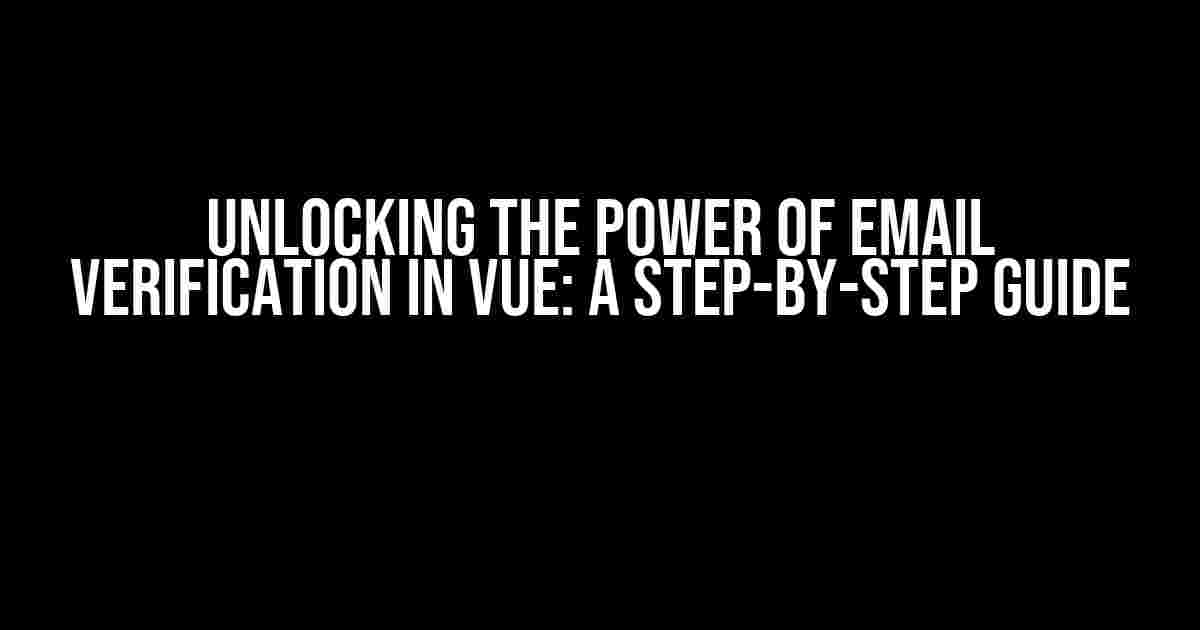As a Vue developer, you’ve likely encountered situations where you need to fetch the current user’s email in a component and verify whether it matches a specific email address or not. This task may seem daunting, but fear not! In this comprehensive guide, we’ll delve into the world of email verification in Vue and provide you with a clear, step-by-step approach to achieve this feat.
Why Verify Email Addresses?
Before we dive into the nitty-gritty, let’s discuss the importance of email verification in Vue components. Verifying email addresses serves several purposes:
- Security**: Verifying email addresses helps prevent unauthorized access and ensures that only legitimate users can interact with your application.
- Personalization**: By fetching the current user’s email, you can personalize their experience, offering tailored content and interactions.
- Data Integrity**: Email verification helps maintain data accuracy, reducing the likelihood of incorrect or outdated email addresses.
Finding the Needle in the Haystack: Fetching the Current User’s Email
To fetch the current user’s email in a Vue component, you’ll need to utilize Vuex, Vue’s state management system. Assume you have a Vuex store set up with an `auth` module that stores the current user’s information.
// auth.js (Vuex module)
export default {
state: {
userInfo: null
},
mutations: {
setUserInfo(state, userInfo) {
state.userInfo = userInfo
}
},
getters: {
getUserEmail: state => state.userInfo.email
}
}
In your Vue component, import the `auth` module and utilize the `getUserEmail` getter to fetch the current user’s email:
// MyComponent.vue
import { mapGetters } from 'vuex'
export default {
computed: {
...mapGetters(['getUserEmail'])
},
mounted() {
console.log(this.getUserEmail) // Output: the current user's email
}
}
The Verification Process: Checking for Matches
Now that you’ve successfully fetched the current user’s email, it’s time to verify whether it matches a specific email address or not. Let’s assume you want to check if the email matches `[email protected]`.
Create a computed property in your Vue component to perform the verification:
// MyComponent.vue
export default {
computed: {
...mapGetters(['getUserEmail']),
doesEmailMatch() {
const targetEmail = '[email protected]'
return this.getUserEmail === targetEmail
}
}
}
The `doesEmailMatch` computed property returns a boolean value indicating whether the current user’s email matches the target email address.
Putting it all Together: A Real-World Example
Let’s create a simple Vue component that fetches the current user’s email and verifies whether it matches a specific email address or not:
// MyComponent.vue
<template>
<div>
<p>Current User's Email: {{ getUserEmail }}</p>
<p>Email Match: {{ doesEmailMatch ? 'Yes' : 'No' }}</p>
</div>
</template>
<script>
import { mapGetters } from 'vuex'
export default {
computed: {
...mapGetters(['getUserEmail']),
doesEmailMatch() {
const targetEmail = '[email protected]'
return this.getUserEmail === targetEmail
}
}
}
</script>
Bonus: Handling Edge Cases and Security Concerns
When working with email verification, it’s essential to consider edge cases and security concerns:
- Null or Undefined Emails**: Handle cases where the current user’s email is null or undefined.
- Email Format Validation**: Validate the email format to ensure it meets specific criteria (e.g., contains an ‘@’ symbol).
- Case Sensitivity**: Be aware of case sensitivity when comparing email addresses.
- Hashed Emails**: If you’re working with hashed emails, ensure you’re comparing the hashed values correctly.
To address these concerns, you can modify the `doesEmailMatch` computed property:
// MyComponent.vue
export default {
computed: {
...mapGetters(['getUserEmail']),
doesEmailMatch() {
if (!this.getUserEmail) return false
const targetEmail = '[email protected]'
return this.getUserEmail.toLowerCase().trim() === targetEmail.toLowerCase().trim()
}
}
}
Conclusion
In this comprehensive guide, we’ve demonstrated how to fetch the current user’s email in a Vue component and verify whether it matches a specific email address or not. By following these steps, you’ll be well-equipped to implement email verification in your Vue applications, ensuring a more secure and personalized user experience.
Remember to consider edge cases and security concerns when working with email verification, and don’t hesitate to adapt the approach to fit your specific use case.
| Keyword | Description |
|---|---|
| How to fetch current user email in Vue component | Fetched using Vuex’s `auth` module and `getUserEmail` getter |
| Check whether this email matches with [email protected] | Verified using a computed property that compares the fetched email with the target email address |
I hope this article provides a comprehensive guide on how to fetch the current user’s email in a Vue component and check whether it matches a specific email address or not.Here are 5 Questions and Answers about “How to fetch current user email in Vue component and check whether this email matches with `[email protected]` or not?”
Frequently Asked Question
Get answer to your Vue.js email validation queries!
How do I fetch the current user’s email in a Vue component?
You can fetch the current user’s email in a Vue component by using the `Vue.prototype.$auth` object, which provides information about the authenticated user. Specifically, you can access the email using `this.$auth.user.email`. This assumes you are using a Vue authentication plugin like Vue Auth.
How do I check if the fetched email matches a specific email address in Vue?
You can check if the fetched email matches a specific email address using a simple conditional statement in your Vue component. For example, `if (this.$auth.user.email === ‘[email protected]’) { /* do something */ }`. This will check if the current user’s email matches `[email protected]`.
Can I use a regex pattern to match the email address in Vue?
Yes, you can use a regex pattern to match the email address in Vue. For example, `const pattern = /^[a-zA-Z0-9._%+-]+@[a-zA-Z0-9.-]+\.[a-zA-Z]{2,}$/; if (pattern.test(this.$auth.user.email)) { /* do something */ }`. This regex pattern matches most common email address formats.
How do I perform case-insensitive email matching in Vue?
You can perform case-insensitive email matching in Vue by converting both the fetched email and the target email to lowercase using the `toLowerCase()` method. For example, `if (this.$auth.user.email.toLowerCase() === ‘[email protected]’.toLowerCase()) { /* do something */ }`. This will match the email address regardless of case.
Can I use a separate function to check the email match in Vue?
Yes, you can create a separate function to check the email match in Vue. For example, you can create a `checkEmailMatch` function that takes the fetched email and target email as arguments. Then, call this function in your Vue component to perform the check. This can make your code more modular and reusable.
Let me know if you need any changes!


